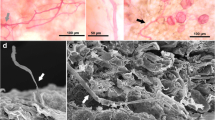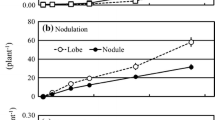Summary
Glycine max (L. Merr. cv. Amsoy 71) plants were grown in a greenhouse in a sand/perlite medium low in plant-available N and P. Plants were either inoculated with a vesicular-arbuscular mycorrhizal (VAM) fungus alone, a strain ofRhizobium japonicum alone, both endophytes together or were left non-inoculated to serve as a control. All combinations received a N-and P-free nutrient solution. Nodulated plants contained 4 to 5 times the phytomass of non-inoculated controls, and plants colonized with both the VAM fungus and Rhizobium were 18% greater in dry weight than nodulated, non-VAM plants due to a positive VAM times Rhizobium interaction. Nitrogen fixation, calculated from C2H4 and H2 data, was significantly higher in the tripartite symbiosis, with 80% of the increase attributable to increased nodule mass and 20% due to increases in specific nodule activity. Colonization by the VAM fungus and the development of vesicles increased significantly following nodulation. The synergistic interactions between the microsymbionts suggests that the response of the host to dual colonization is complex and depends on a balance between the three members of the symbiosis.
Similar content being viewed by others
References
Allen M F, Moore T S and Christensen M 1980 Phytohormone changes inBoteloua gracilis infected with vesicular-arbuscular mycorrhizae I. Cytokinin increases in the host plant. Can. J. Bot. 58, 371–374.
Ames R N, Reid C P P and Ingham E R 1984 Rhizosphere bacterial population responses to root colonization by a vesicular-arbuscular mycorrhizal fungus. New Phytol. 96, 555–563.
Asai T 1944 Ube die Mykorrhizenbildung der Leguminosempflanzen. Jap. J. Bot. 13, 463–485.
Asimi S, Gianinazzi-Pearson V and Gianinazzi S 1980 Influence of increasing soil phosphorus levels on interactions between vesicular-arbuscular mycorrhizae and Rhizobium in soybeans. Can. J. Bot. 58, 2200–2205.
Azcon-Aguilar C and Barea J M 1981 Field inoculation ofMedicago sativa with vesicular-arbuscular mycorrhiza andRhizobium meliloti in phosphate-fixing agricultural soils. Soil Biol. Biochem. 13, 19–22.
Azcon-G. de Aguilar C, Azcon R and Barea J M 1979 Endomycorrhizal fungi and Rhizobium as biological fertilizers forMedicago sativa in normal cultivation. Nature 279, 325–327.
Bagyaraj D J, Manjunath A and Patil P B 1979 Interactions between a vesicular-arbuscular mycorrhiza and Rhizobium and their effects on soybeans in the field. New Phytol. 82, 141–145.
Bethlenfalvay G J, Brown M S and Pacovsky R S 1982 Relationships between host and endophyte development in mycorrhizal soybeans. New Phytol. 90, 537–543.
Bethlenfalvay G J, Pacovsky R S, Bayne H G and Stafford, A E 1982 Interactions between nitrogen fixation, mycorrhizal colonization and host plant growth in thePhaseolus-Rhizobium-Glomus symbiosis. Plant Physiol. 70, 446–450.
Bethlenfalvay G J and Phillips D A 1977 Ontogenic interactions betwen photosynthesis and symbiotic nitrogen fixation in legumes. Plant Physiol. 60, 419–421.
Cassman K G, Whitney, A S and Fox R L 1981 Phosphorus requirements of soybean and cowpea as affected by mode of N nutrition. Agron. J. 73, 17–22.
Crush J R 1974 Plant growth responses to vescular-arbuscular mycorrhiza VIII. Growth and nodulation of some herbage legumes. New Phytol. 73, 743–749.
Crush J R 1973 The effect ofRhizophagus tenuis mycorrhizas on ryegrass cocksfoot, and sweet vernal. New Phytol. 72, 965–973.
Demeterio J L, Ellis R Jr. and Paulsen G M 1972 Nodulation and nitrogen fixation by 2 soybean varieties affected by phosphorus and zinc nutrition. Agron. J. 64, 566–569.
Fehr W R and Caviness C F 1977 Stages of soybean development. Special Report 80, Cooperative Extension Service, Iowa, pp. 1–11.
Ganry F, Diem H G and Dommergues Y R 1982 Effect of inoculation withGlomus mosseae on nitrogen fixation by field-grown soybeans. Plant and Soil 68, 321–329.
Gianinazzi-Pearson V, Fardeau J C, Asimi S and Gianinazzi S 1981 Source of additional phosphorus absorbed by vesicular arbuscular mycorrhizal soybeans. Physiol. Veg. 19, 33–44.
Mosse B, Powell C L and Hayman D S 1976 Plant growth responses to vesicular-arbuscular mycorrhiza. Part 9 Interactions between vesicular-arbuscular mycorrhiza, rock phosphate and symbiotic nitrogen fixation. New Phytol. 76, 331–342.
Pacovsky R S, Bayne H G and Bethlenfalvay G J 1984 Symbiotic interactions between strains ofRhizobium phaseoli and cultivars ofPhaseolus vulgaris L. Crop Sci. 23, 101–105.
Pacovsky R S, Bethlenfalvay G J and Paul E A 1986 Comparisons between phosphorus-fertilized and mycorrhizal plants. Crop Sci.,In press.
Pacovsky R S, Fulle, G and Paul E A 1985 Influence of soil on the interactions between endomycorrhizae and Azospirillum in sorghum. Soil Biol. Biochem. 17, 525–531.
Pacovsky R S, Paul E A and Bethlenfalvay G J 1986 Response of mycorrhizal and phosphorus-fertilized soybeans to nodulation by Bradyrhizobium or ammonium nitrate. Crop Sci. 26, 145–150.
Ross J P and Harper J A 1970 Effect of Endogone mycorrhizae on soybean yields. Phytopathol. 60, 1552–1556.
Schenk N C and Hinson K 1973 Response of nodulating and non-nodulating soybeans to a species of Endogone mycorrhiza. Agron. J. 65, 849–850.
Schubert K R and Evans H J 1976 Hydrogen evolution: A major factor affecting the efficiency of nitrogen fixation in nodulated symbionts. Proc. Nat. Acad. Sci., USA 73, 1207–1211.
Shelton W R and Harper H J 1941 A rapid method for the determination of total phosphorus in soil and plant material. Iowa State Coll. J. Sci. 15, 403–413.
Smith S S E 1980 Mycorrhizas of auxotrophic higher plants. Biol. Rev. Camb. Philios. Soc. 55, 475–510.
Watanabe F S and Olsen S R 1965 Test of an ascorbic acid method for determing phosphorus in water and NaHCO3 extracts from soil. Soil Sci. Soc. Proc. 29, 677–678.
Author information
Authors and Affiliations
Additional information
Contribution from the Western Regional Research Center, USDA-ARS (CRIS No. 5102-20170001) in collaboration with the University of California.
Rights and permissions
About this article
Cite this article
Pacovsky, R.S., Fuller, G., Stafford, A.E. et al. Nutrient and growth interactions in soybeans colonized withGlomus fasciculatum andRhizobium japonicum . Plant Soil 92, 37–45 (1986). https://doi.org/10.1007/BF02372264
Received:
Revised:
Issue Date:
DOI: https://doi.org/10.1007/BF02372264




